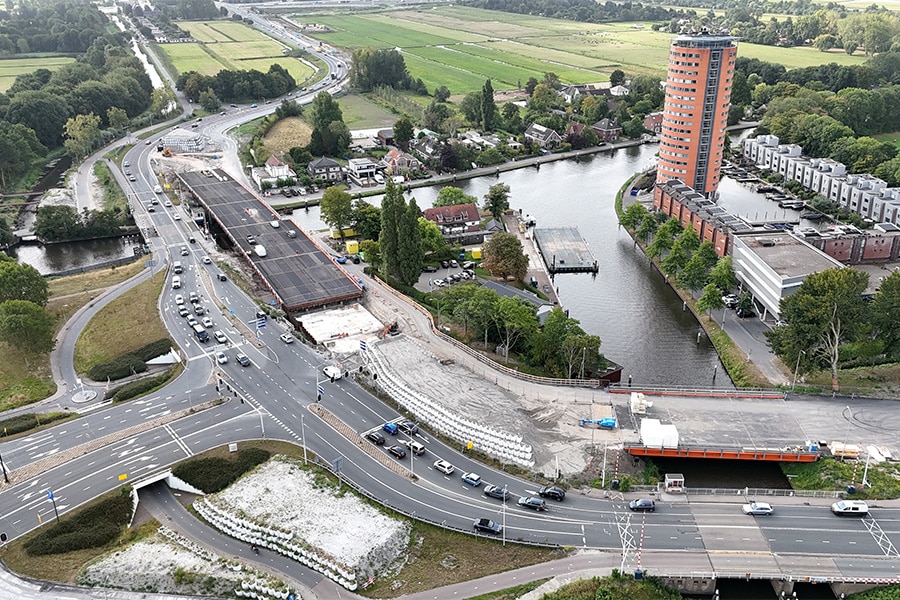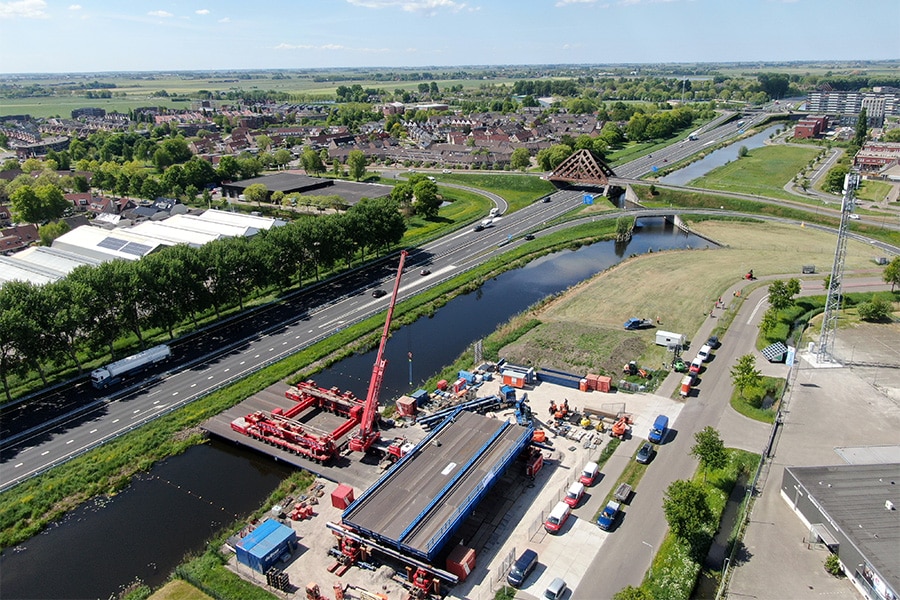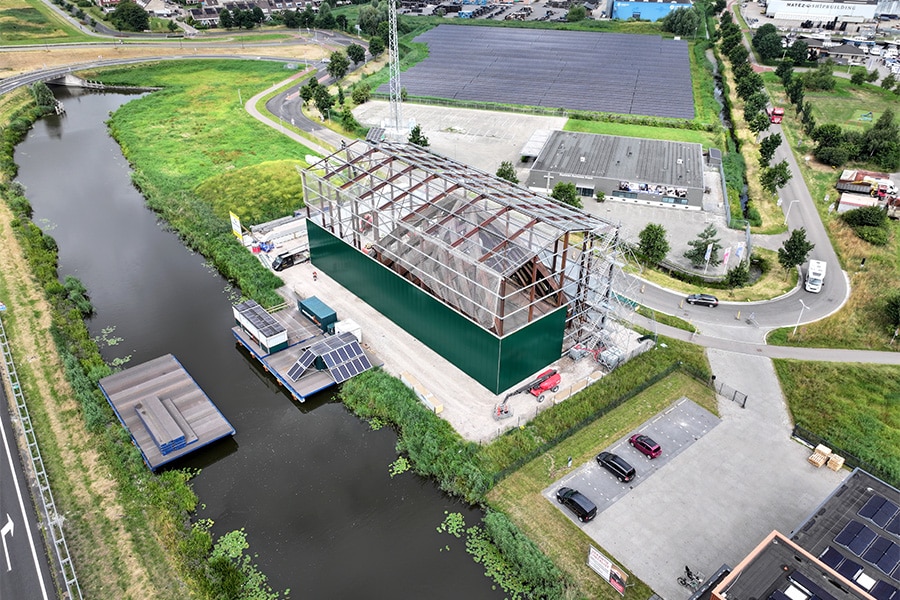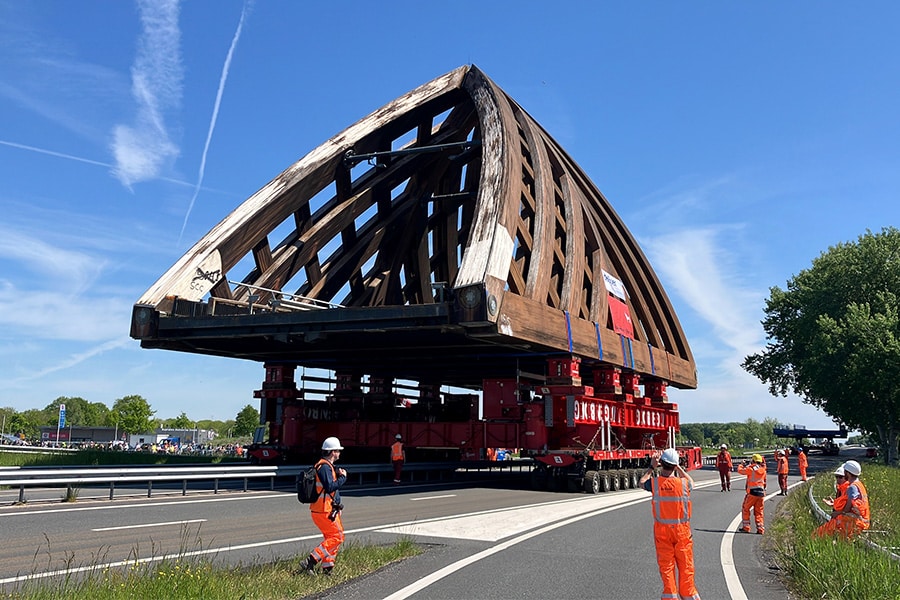
Monumental Berlage Bridge future-proofed again: 'Nice script'
The iconic Berlage Bridge connects East and West Amsterdam. The busy bottle neck will be closed to all traffic for four months. Time badly needed by Combinatie Berlagebrug - consisting of Mobilis and Machinefabriek Rusthoven - to take care of the monumental bridge near Amstel Station. The goal is to renovate and strengthen the bascule bridge. A complicated job with a nice playbook.
Designed by architect Berlage in 1932, the Berlage Bridge immediately stands out for its robust appearance with striking posts and bricks. In the 1930s, the automobile was still special. By now, pedestrians, cyclists, streetcars and freight traffic pass alongside cars. Boating traffic under the bridge is also a hive of activity. Bridge number 423 has a rich history, but was in urgent need of a refurbishment to make it future-proof.
Harvesting
Mobilis project coordinator Paul Enter walks the unusual construction site above the Amstel River with a smile. "It runs well out here. I do like the commotion." For four months, the Berlage Bridge will be completely closed. On the bridge deck, Mobilis and Rusthoven are working hard. At the same time, Struijk is involved in the project for the demolition work - "we call that harvesting of released materials here" - and Van Gelder for the road surface.
First, the monumental streetcar masts were carefully loosened and the roof of the bascule basement was cleared in the middle of the bridge. The 32 light and streetcar fixtures will receive a refurbishment in the restoration hall at Smederij Oldenhave where the monumental railings have already been moved as well.
Mobilis is no stranger to Amsterdam, having renovated the Amstel Station, built the Amstelstroomburg and is continuing work on the Singelgracht garage and Amsterdam Zuid Station (OVT), among other projects. Paul has also been a daily visitor to Amsterdam for several years and previously worked on the Amstel Stream Bridge, Bridge 295 and the quay walls along the Singel. "Amsterdam is Amsterdam after all. In such a big city, everything is just different."

Communications
Paul just finished a construction meeting with the community. "Communication is extra important with this project. We're right here in the middle of town. Of course you take that into account. We can't work constantly and pay attention to noise and nuisance. Keeping everyone well informed is just as important as the execution. We are guests here, after all." Even the noise levels for fish were measured.
The urban environment is a logistical challenge and there is no room for a construction shack. Fist-thick roadmaps are needed for the replacement operation. In which the coordination with the municipality and shipping industry listens closely. Of course, the accessibility of the adjacent rowing club and marina has been considered. And not forgetting that every step and intervention was coordinated with Monument Conservation, because the Berlage Bridge has the status of a National Monument.
Orange work surfaces
With cheerful Green Construction Fences, the construction site has been carefully cordoned off and immediately the adjacent streetcar track and the Amsteldijk/Vrijheidslaan intersection are being taken in hand. On the bridge, sleek line patterns are outlined of orange work surfaces to work along. Lines that correspond one-to-one with the BIM design and plan of action.
Cars and streetcars will have to detour during the closure. A temporary and circular auxiliary bridge has been built right next to the Berlage Bridge for pedestrians, cyclists and emergency services. TBI partners City Barging provided the logistics across the water and Voorbij Funderingstechniek undertook the substructure to build the temporary bridge.
Benchmarks
Nearly two years preceded the preparation of the renovation project. The design was 3D measured and completely worked out in BIM with clash detection. The existing bridge was taken as the starting point on which dozens of benchmarks were applied. The assignment is thorough renovation and reinforcement to handle heavier traffic in the coming decades.
This sounds relatively simple, but requires a lot of calculation and drawing work including the necessary brain teasers. Extra complex is the monumental status of the bridge. It is important that the bridge function again for decades as an important traffic artery. However, its status as a national monument requires careful handling of the bridge's history, leaving out modifications as much as possible.
Balancing
"That's balancing between interests," Paul knows from daily practice. For example, the new trap had to be one and a half times as strong to carry the heavier traffic. That choice had the consequence that the associated installations no longer fit in the existing basement. And then? After much deliberation, a hydraulic drive system was chosen that is more compact in size and does fit.
We take a look in the cramped basement under the bridge. Paul points out a special detail on the wall, the original instructions from the 1930s: 'Extract from the Electrical Safety Decree 1938' reads
er with thick black letters. They are the operating regulations with twelve articles on the operation of the bridge. In the first phase, the basement is empty, but within a few months the 5-by-16-meter space will be filled again with installations and ballast boxes.
A component performed by Sissing North and Hydroton.
Distribute lifting loads
"These four months are the most exciting part of the operation, culminating in the replacement of the trap. The movable section consists of three parts, with the middle one suitable for streetcars. This requires a large crane on the bridge that lifts the old parts out and a month later puts the new parts in place. Actually, it's six hoists, three parts halyard and three parts counterweight box. To relieve the monumental part, the choice was made to divide the lifting loads and the ballast boxes are disconnected from the fall parts. The bridge is continuously monitored during these lifting operations."
Paul: "A secure and difficult job for which we have already done a lot of preparation. Phasing, coordination and communication are very important here. With the environment and of course also during the execution with the people working here on the construction site. We have a good plan and a good schedule. You can rely on that." From mid-November, the Berlage Bridge will once again be in use as a traffic artery from East to West and streetcar 12 will run in the middle of the bridge as before.
Berlage Bridge (1932)
Project: renovation and major maintenance
Characteristics: Bascule bridge (bridge 423).
Client: Municipality of Amsterdam
Contractor: Combination Berlage Bridge Mobilis and Machinefabriek Rusthoven.
Special: National Monument
Awarded: September 2021
Planned implementation: 2022-Dec 2023
Contract price: 12 million euros
Auxiliary bridge: 8 by 100 meters
Learn more about the history of the gateway between East and West.
Heeft u vragen over dit artikel, project of product?
Neem dan rechtstreeks contact op met Mobilis.
 Contact opnemen
Contact opnemen




